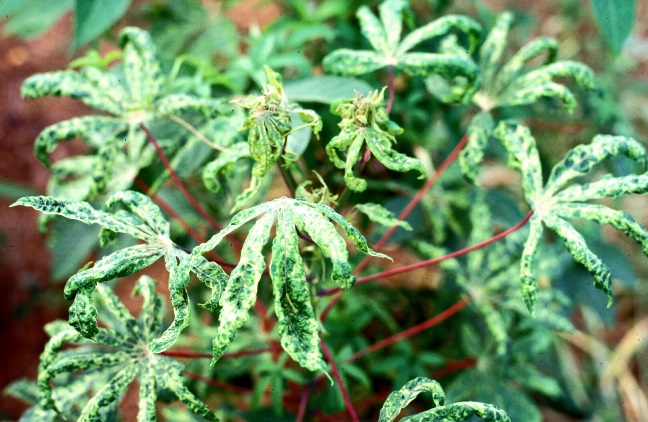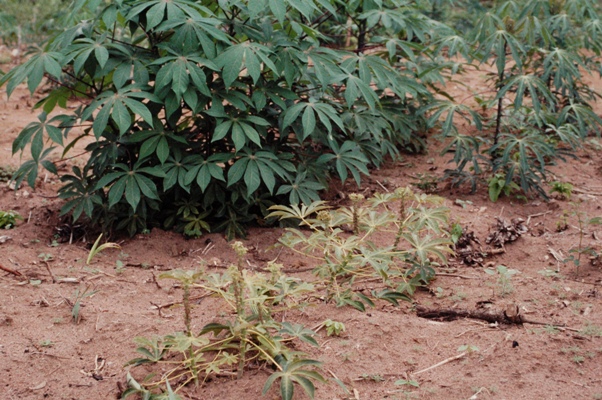Health diagnosis of cassava genetic resources
Contributors to this page: CIAT, Colombia (Daniel Debouck, Roosevelt Escobar, Graciela Mafla); IITA, Nigeria (Dominique Dumet); Bioversity International/ILRI, Ethiopia (Alexandra Jorge); independent consultant (Clair Hershey).
List of pests and diseases of quarantine importance for cassava
|
|
Click here for additional information on the safe transfer of germplasm of clonal crops.
The list below mentions some of the pests/diseases that are considered important worldwide, but many of them may or may not have relevance in specific countries. It also does not consider pests/diseases of limited relevance (e.g. only important in very few countries). A further disease list can be found here.
The Americas have the greatest diversity of cassava pests, followed by Africa and then Asia. Damage in Africa is often high due to the lack of natural predators of pests.
- The green mite (Mononychellus tanajoa) (Americas and Africa) and the mealybug (Phenococcus manihoti and P. Herreni) cause major damage in Africa, and recently in Asia.
- Whiteflies (Aleurotrachelus socialis and A. aepim), hornworm (Erinnyis ello), stemborers (Chilomina clarkei), burrower bugs (Sternocoelus manihoti and Tropidozineus fulveolus), thrips (Frankliniella williamsi) and lacebugs (Vatiga manihoti, V. illudens and Amblydtira machalana) are a problem in the Americas.
- Scales (Aonidomytilus albus), termites and grasshoppers are also widely reported.
-
Amongst the main cassava diseases there are the complex of:
- Cassava mosaic diseases (CMD) caused by the African cassava mosaic virus (ACMV), the East African cassava mosaic virus (EACMV) and by the South African cassava mosaic virus (SACMV).
- The cassava brown streak virus (CBSV) in Africa.
- In South America, the main viral diseases are caused by the cassava common mosaic virus (CsCMV and CsXV) and by the cassava frogskin virus (CFSV).
- Other diseases like cassava bacterial blight (CBB) or those caused by fungi, like cassava anthracnose and root rot, are important worldwide.
Recommended methods to detect the presence of each pest or disease
Viruses
- ELISA, TBIA, PCR, seedling symptom test, indicator test.
-
Use extra grafting techniques to test cassava materials for Frogskin disease.
- Virus tested plants should be transplanted into sterilized soil and retested for Frogskin disease by grafting to a healthy hypersensitive clone such as cv. Secundina.
- Plants tested negative in all tests should be available for distribution.
- If plants are tested virus positive they can either be discarded (if more plants of the same accessions are tested virus negative) or enter again into the thermotherapy process and meristem culture.
Fungi
Blotter test, agar test, washing test, direct visual inspection.
Bacteria
Seedling symptom test, dilution plating test.
Weeds, insects and nematodes
|
|
Direct visual inspection.
Testing intervals/seasons
Testing before material goes into the genebank or to the field is important to reduce transfer of diseases or pests.
Viruses
Test seedlings before transfer to the field for regeneration or during regeneration and rogue infected material.
Fungi
Test plant propagules on entry to genebank and regularly thereafter. Rogue infected material.
Bacteria
Test plant propagules on entry to genebank and regularly thereafter. Rogue infected material.
Weeds, insects and nematodes
Test plant propagules on entry to genebank and regularly thereafter. Rogue infected material.
Recording information during health diagnosis
The following information should be recorded for each health diagnosis step:
- Site name and map/GPS reference.
- Name of collaborator.
- Field bank site name (a code to identify the site location).
- Plot reference (the plot number at the field site).
- Accession number; population identification.
- Name of staff (name of staff recording the data).
- Date of monitoring (date when data is collected).
- Date of test (the date that the test was commenced).
- Number of replications (the number of replicates in the test).
- Size of the samples per replication.
- Pre-treatments (pre treatments used for the test).
- Media (the media for the test) (e.g. for fungi).
- Material (plant part used).
- Pathogen tested (name of pathogen tested).
- Test method (method used).
- Percentage infection (% of plants or samples infected).
References and further reading
Frison EA, Feliu E, editors. 1991. FAO/IBPGR Technical Guidelines for the Safe Movement of Cassava Germplasm. Food and Agriculture Organization of the United Nations, Rome/International Board for Plant Genetic Resources, Rome.
Nolt B, Velasco AC, Pineda B. 1991. Improved purification procedure and some serological and physical properties of Cassava Common Mosaic Virus from South America. Ann. Appl. Biol. 118:105-113.
Nolt B, Pineda B, Velasco AC. 1992. Surveys of cassava plantations in Colombia for virus and virus-like diseases. Plant Pathology 41: 348-354.
Velasco AC, Nolt B, Pineda B. 1990. Comparación de tres métodos de la técnica inmunoenzimática "Elisa" para el diagnóstico de virus del mosaico común de la yuca. Fitopatología Colombiana 14(1):3-9.
Comments
- No comments found







Leave your comments
Post comment as a guest